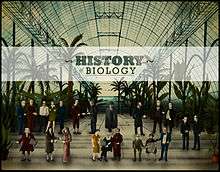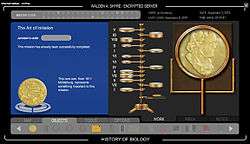History of Biology (video game)
History of Biology is a browser based scavenger hunt style educational game created by Spongelab Interactive. It is designed to teach high school students and general interest groups about the history of biology
| History of Biology - educational science game | |
|---|---|
 | |
| Developer(s) | Spongelab Interactive |
| Publisher(s) | Spongelab Interactive |
| Platform(s) | Windows, Mac OS X |
| Release | 2010 |
| Genre(s) | Educational |
| Mode(s) | Single player Online |
the role of a research assistant given the task of a solving a series of puzzles and clues left by a scientist, Dr. Walden Shyre, who has mysteriously disappeared. The puzzles that players solve are connected by a story line that progresses through a series of emails that are displayed once the player has solved a mission. There are 14 missions with one or two puzzles to solve in each mission. Players investigate objects within the game to find clues or uncover the answer by surfing real and fictitious web sites. Users explore pivotal discoveries that laid the foundation of our current understanding of biology.[1]
The purpose of the game is to teach the discoveries and research of over 20 scientists, as the missions are completed. For instance, in the first mission called, "The Art of Imitation", players learn about Zacharias Janssen, who is credited with inventing the compound microscope. The scientists highlighted in this game are: Anthonie Van Leewenhoek, Robert Hooke, Matthias Schleiden, Theodor Schwann, Rudolf Virchow, Carl Linnaeus, Jean-Baptiste Lamarck, Gregor Mendel, Charles Darwin, Alfred Russel Wallace, Johannes Friedrich Mieschner, Oswald Avery, Colin MacLeod, Maclyn McCarty, Alfred Hershey, Martha Chase, James D.Watson, Francis Crick, Rosalind Franklin, Fredrick Sanger, and Kary Mullis.


Various scientific discoveries from the 15th century through to the 21st century are dealt with in this game. Cell theory is explored by analyzing letters and a stamp. Finding the answer to this clue means researching terms such as metabolism, nerve cells and pepsin. To introduce mechanisms of diversity and the work of Charles Darwin, players explore maps, find GPS coordinates and read about Darwin's research with finches.
The clues in each mission are randomized so every player has a different path to determine the solution; although the overall mission is the same for everyone. This allows for players to use a variety of methods to complete a mission and move on to the next level.
This game provides an interactive way to learn about historical events in biology.
Rewards
As players complete each mission, they are sent a victory email from one of the game characters. This email usually contains a teaser about what the next mission will entail.
Additional educational features
A notepad is visible in all missions to make notes along the way, create a progress journal and ask questions.
Supportive features for teachers
The notepad feature in History of Biology, which is visible to teachers, allows the teacher to answer questions or deal with specific content students may be interested in or struggling with, in class. Also for the teacher, is a detailed teacher's guide with a walk through of each mission. A back end administration area gives teachers the option of controlling which missions are available to students.
In the news
- Caron, Nathalie (2010-11-30). "Decoding Biology with Spongelab Interactive". gamefwd. Retrieved 2010-11-30.
- Buckler, Grant (2010-11-30). "Canadian startups find opportunity in educational games". itbusiness.ca. Retrieved 2010-11-30.
- "Go On A Scavenger Hunt in History of Biology from Spongelab". Village Gamer. 2010-08-23. Retrieved 2010-08-23.
- Wilson, Joseph (2010-07-28). ""No ma, this game is helping me learn" - Toronto's serious gaming companies have kids thinking". Yonge Street. Retrieved 2010-07-28.